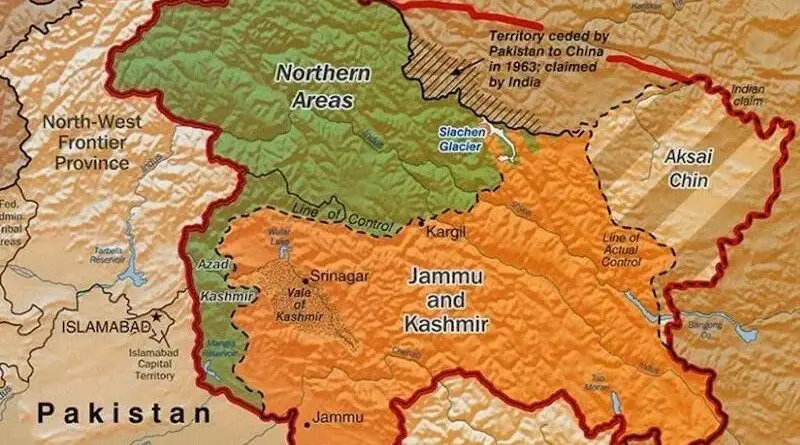One Year Of Ceasefire At LoC – OpEd
The relations between India and Pakistan have been defined by the violent partition after British rule ended in Subcontinent in 1947. It led to the Kashmir conflict (1948 war), soon after the independence and later war of 1965, 1971 and than Kargil conflict in 1999. Since than the relations between the two countries are not only bitter but sometime seen adverse.
India’s involvement in Pakistan is undeniable evidence. India is not aiding and financing insurgents in Baluchistan but helping terrorists in Pakistan. Sponsoring terrorism against Pakistan is India’s state policy to sabotage the peace efforts especially China Pakistan economic corridor (CPEC) which is unbearable for India. In November, 2020, Pakistan had presented a detailed dossier to India including details, highlighting the terror financing, phone calls, indicating network linkages and a terrorism racket run by India against Pakistan. Dozens of Indian consulates in Afghanistan were the main hub of terror sponsorship against Pakistan.
These all things led to a Kashmir clashes or a ceasefire violations at the Line of Control (LoC) that is Pak-India international border. The unprovoked cease-fire violations by Indian forces compel Pakistan to respond accordingly which resulted loss of civilian causalities from both sides of LoC. After the Indian misadventure in Balakot and abrogation of Article 370 in Kashmir, the ceasefire violations at the border increased than the past. Pak-India shares total length of 3,323 km-long border with of which 221 km of the International Border (IB) and 740 km of the Line of Control (LoC) which fall in Jammu and Kashmir.
In 2003, Pakistan and India mutually declared a cease-fire agreement at the LoC, to ease regional tensions. However, the ceasefire has been almost torn apart due to unstable relations between the neighboring countries. Pakistan vows to maintain peace and strengthen border relations with India but could not reach its promises due to India’s aggressive behavior.
Its been one year of ceasefire at LoC. The people along the Line of Controls (LoC) and other parts of border have been enjoying good time, as there have been no ceasefire violation reported since the ceasefire agreement came into affect last year on 25 February 2021. It was seen first time in 18 years that no single bullet was fired along the international border. Otherwise both sides frequently used artillery, mortars, and small arms at the LoC. According to Inter Services Press Release (ISPR) there have been 2340 ceasefire violations made by Indian troops in 2020, which were too high in number since 2003.
Last year February 24, 2021 both Pakistan and India had committed once again to the 2003, ceasefire arrangement at the Line of Control and agreed to address the ‘core issues’ that “could undermine peace and stability”. The Director Generals of Military Operations (DGMOs) of both sides had established a hotline communication and discussed the India-Pakistan border situation and announced ceasefire with effect from midnight of 24/25 February 2021. Further, the two sides “reiterated that existing mechanisms of hotline contact and border flag meetings will be utilized to resolve any unforeseen situation or misunderstanding”. The joint statement was the result of back channel talks between National Security Advisers (NSA’s) of both India and Pakistan.
In February this year, Indian Army Chief General Naravane made a shocking statement claiming that the ceasefire agreement on the Line of Control (LoC) was holding because India had negotiated from a “position of strength”. Which was later rejected by the (ISPR) Director General Maj Gen Babar Iftikhar. He termed the claim “clearly misleading”. He said ceasefire was agreed “only due to Pakistan’s concerns for the safety of people of Kashmir living on both sides of the LoC”. “No side should misconstrue it as their strength or other’s weakness.” Such type of irresponsible statement from a responsible position is unreasonable which could further derail or sabotage the peaceful agreement.
If ceasefire continues than there will be no civilian causalities and it will provide relief to the trades of both sides. It will also end the dangers of confrontation and hostilities on the India-Pakistan border. In the wake of successful ceasefire implementation, now both countries can re-establish their full diplomatic relation which were down grade by Pakistan after the India’s illegally abrogation of article 370 in Jummu and Kashmir. Trade which was also suspended can be restored and trade relations can be normalized with goodwill gesture.
India standoff with China at Line of Actual Control (LAC) and Taliban takeover in Afghanistan are the main reasons that India had accepted the proposal of Pakistan over ceasefire agreement which is continue without any violation. This is a good sign, no matter what reason are, because it is in the interests of both sides. It is also the log been desire of people living near the LoC, because ceasefire violations badly effects both sides of civilians.
Pakistan always want good and cordial relations with India on mutual respect, as Prime Minister Imran Khan repeatedly said if India one step comes we will go two steps. Pakistan desire for peace does not mean, its Pakistan weakness. Its the desire which belongs to the millions of people living across the border. The decision regarding the ceasefire at LoC is a welcome and appreciated decision and hope that this will go too long and the remaining issues will be discuss through a smooth and progressive manner by both countries.
*The writer is Islamabad based Researcher and Freelancer

